|
The King Regula III series featured a complete redesign of the camera body. The bodies were considerably larger than those of the two series and received a distinctive large rectangular front plate with a King emblem. They were sturdy cameras that had a solid feel to them. The wind mechanism still featured the 'Regula chain'.
King Regula IIIa
The King Regula IIIa was a viewfinder camera with either a Steinheil Cassar f/2.8 lens or Rodenstock Trinar f/2.8 lens. It had a lever wind with a frame counter integrated in the wind knob. The shutter was a Prontor-SVS, which features a synchronising lever with V setting for time-delayed action.
A rather rare version was one with a Ghetaldus Ghenar lens. It didn't have the typical black ring marked 'Regula-Werk King KG Bad Liebenzell' around the lens and it had a smooth lens base instead of an indented one like on the regular IIIa model. Furthermore, it came with a Pronto shutter (not a Prontor-SVS) that included a flash sync socket, whereas on the regular IIIa this was located on the front plate. It looked, in fact, like an early version of the King Regula IIb below, which was produced in Germany but had a lens made in former Yugoslavia, and was presumably sold there. Curiously, the serial number of one of these 'Ghenar' IIIa (most did not have serial# for some reason) is the lowest of all III series cameras. Was this the first III series model ever build?
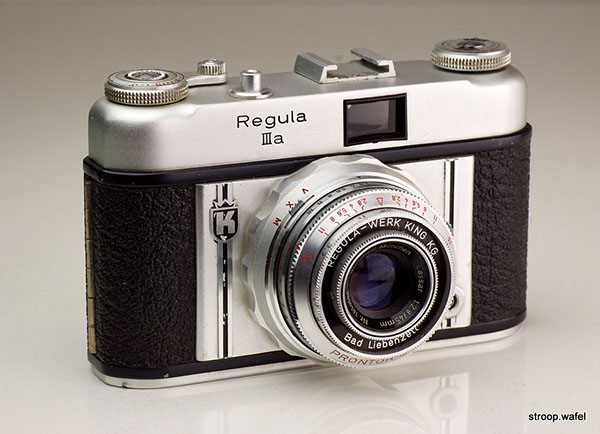
A King Regula IIIa with Cassar f/2.8 lens in Prontor-SVS shutter. These shutters are prone to problems. They charge the time delay each time the shutter is cocked and release it instantaneously when the shutter is fired, unless the switch is set to V. The mechanism gets easily damaged when it does not work properly.

A King Regula IIIa with Ghetaldus-Zagreb Ghenar AR 45mm f/3.5 lens.

A slightly different (from the one above) King Regula IIIa with Ghenar f/3.5 lens. This one has no strap lugs and the lens itself is a little different, in fact it looks more like the lens-shutter combination of II series Regulas.
King Regula IIb
The King Regula IIb was an unusual camera in the III series. Even though it had the body of III series cameras, its model number was IIb. This was not completely unprecedented, the King Regula Id, for instance, was part of the II series. In addition, the lens on this camera was a Ghetaldus-Zagreb Ghenar, which came from former Yugoslavia. The case that came with the camera also had the Ghetaldus logo. Nevertheless, the camera itself says 'Made in Germany'. Perhaps Regula-Werk King KG struck a deal with fomer Yugoslavia authorities to be able to sell their cameras in the part of the world.
The camera itself was a simple viewfinder with a four-speed Pronto shutter, and very similar to the Mastra V35 below, or indeed the Regula IIIa with Ghenar lens above. In fact, it is a little baffling that two such similar cameras were marketed at the same time.
More information on Ghetaldus lenses, including a surprisingly long list of Regula variants with such lenses, can be found on �iga's blog.

King Regula IIb built in former Yugoslavia, very similar to the Regula IIIa.
Mastra V35
The Mastra V35 was a rebranded camera built by Regula-Werk King and very similar to the King Regula IIIa, but with a simple Vero shutter. It also had the smaller rewind knob of later III series models and lacked the characteristic Regula rectangular front plate. It appears to have been produced for the UK market with the focus scale in feet.
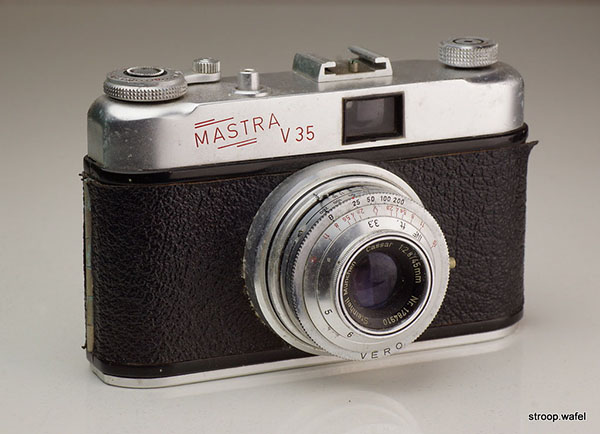
A Mastra V35 in fairly rough condition. This is how I often get them!
King Regula IIIb
This camera was nearly identical to the King Regula IIIa but included a Gossen exposure meter. Due to the size of this unit the rewind knob had to be made smaller and the viewfinder was moved to the right.
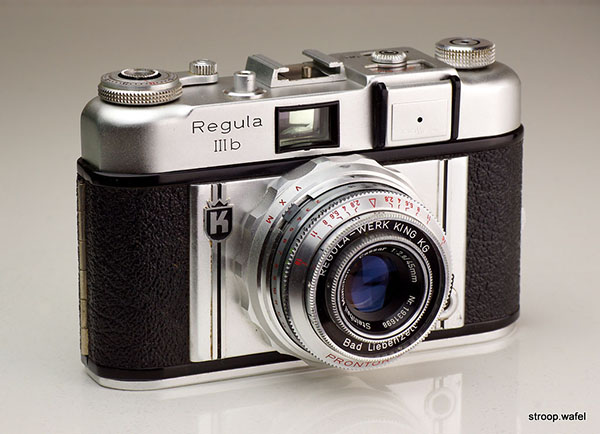
A King Regula IIIb with a Cassar lens. It came also with a Rodenstock Trinar lens, which is the version pictured in the instruction manual. Note the bulky exposure meter.
King Regula Cita III
The King Regula Cita III was essentially a Regula IIIb with added coupled rangefinder. To get a large enough base for the rangefinder, the viewfinder was moved slightly to the left compared to the Regula IIIb. In addition, the Cita III featured helical focussing instead of front-cell focussing like the IIIa and IIIb. The reasoning behind the name Cita III is not immediately obvious, IIIc would perhaps have made more sense but that was the name reserved for the rangefinder model with interchangeable lens mount. Most likely it was a play on the name of the King Regula Cita, the II series model with coupled rangefinder.
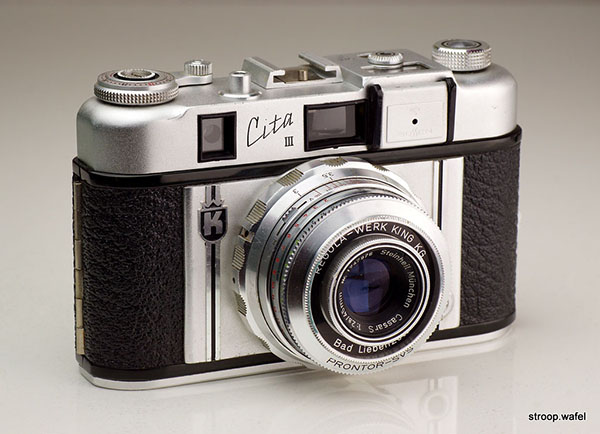
King Regula Cita III with Cassar lens. It was also available with a Carl Zeiss Tessar lens (see below) and there are rare models with Gethaldus Ghettar f/2.8 and Enna Ennalyt f1/.9 lenses.
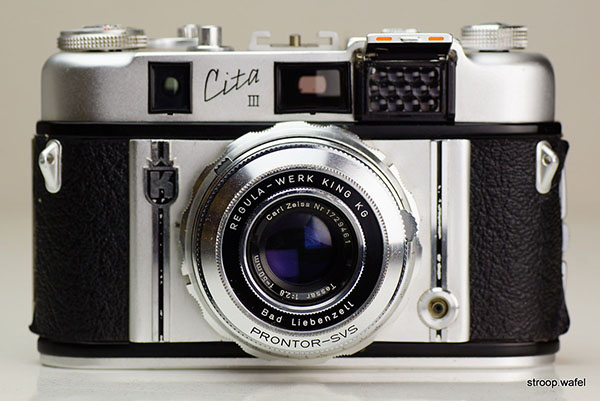
King Regula Cita III with Tessar f/2.8 lens and strap lugs.

A name variant of the Cita III was branded 'OGA'. It was identical to the Cita III other than the name badge. The name OGA was derived from Obergasner, a German distributer that sold rebranded cameras from a variety of suppliers, including King, Wirgin and Franka. Another OGA marketed several years later can be found further down the page.
King Regula IIId
The King Regula IIId was the top model of the III series at the time. Not only did it have a coupled rangefinder added compared to the IIIb, it also featured an interchangeable lens mount. This Prontor mount was meant to compete with the Compur Deckel mount found on, e.g., the Kodak Retina IIIS and Voigtlander Vitessa. Only a few cameras had the Prontor interchangeable mount, including the Braun Paxette Super III and the Photavit 36 (see Braun Super III for detailed comparison of the mounts). The King Regula IIId did not have different frames in the viewfinder for different lenses, so an external viewfinder was necessary for accurate composition of photographs, as the one shown on the Regula IIIc above. Aperture and focus control were done on the lens.
There are two versions of this camera, the first had a light meter identical to the King Regula IIIb and Cita III, the second version had a light meter without flap but with a round display on top of the camera and a larger viewfinder window. It was in fact very similar to the later IIId Automatic, but without a coupled light meter.
According to information from that time, the following non-standard lenses were available: a 28mm f/3.5 Ultra-Lithagon, a 35mm f/3.5 Lithagon, a 90mm f/3.5 Ennalyt and a 135mm f/3.5 Ennalyt. Although I have seen the Ultra-Lithagon in Braun Paxette Super II version, I have yet to discover one for the King Regula [update: I found one! see below].

First version of the King Regula IIId with light meter and rangefinder similar to earlier Regula III models.

Second version of the King Regula IIId with updated light meter and rangefinder window in comparison with to the first version above. This example sports a fast Isco-Göttingen Regula-Color-Westagon 50mm f/1.9 lens.
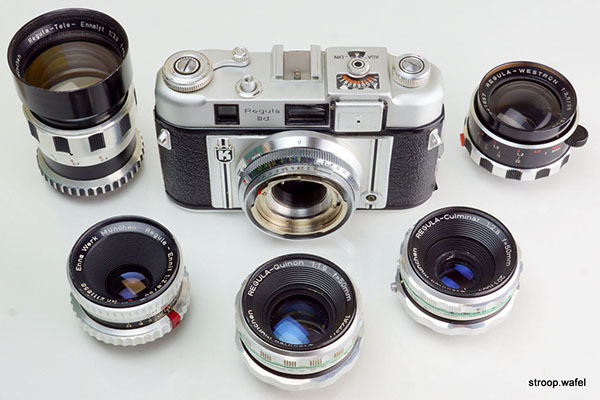
King Regula IIId body with a range of lenses, from left to right a 135mm f/4 Enna Werk Regula-Tele-Ennalyt, a 50mm f/2.8 Enna Werk Regula-Ennit, a 50mm f/1.9 Steinheil Regula-Quinon, a 50mm f/2.8 Steinheil Regula-Culminar and an Isco 35mm f/3.5 Regula-Westron. The Ennit was the most common standard lens on this model.
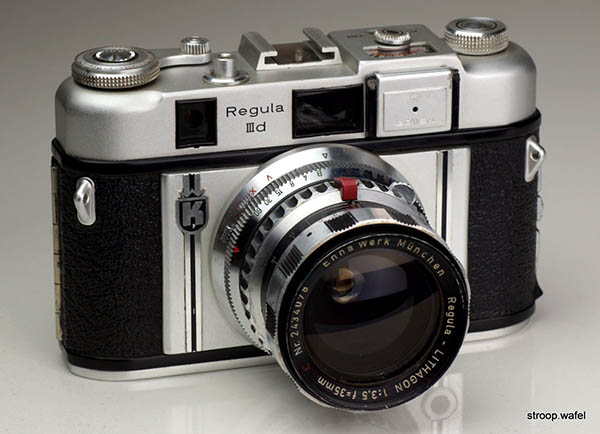
A more recent acquisition was this Enna-Werk Regula-Lithagon 35mm f/3.5 lens. It looks similar in optical design as the Isco Westron 35/3.5 mm shown in the outfit photo above, with a very large bulging front element and deep set rear groups.
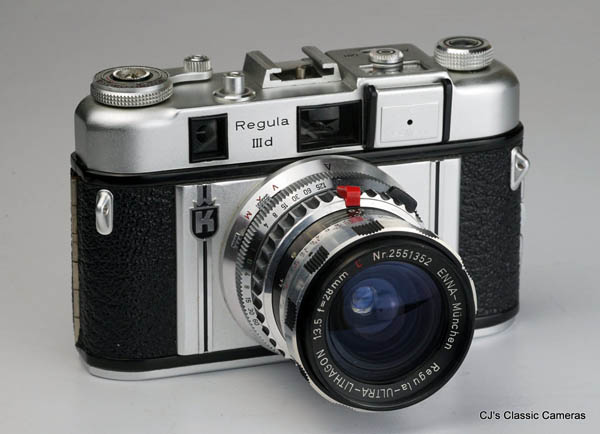
And now I've finally also found an Regula-Ultra-Lithagon 28/3.5 mm lens. Although I had seen the Braun Paxette version, I'd never actually found evidence of the existence of the Regula version, that is, until I saw one for sale. I've seen another one advertised since, but it is an extremely rare version of this lens. The front element of this lens is surprisingly a little smaller than that one on the 35mm Lithagon. However, this is a much more complex six-element lens compared to the 35mm, which only has four.
King Regula IIIc
This King Regula IIIc was very similar to the King Regula IIId but lacked an exposure meter. It therefore had more space in the top housing, which was used to extend the rangefinder base. It had an interchangeable lens mount, more info about which can be found in the section below about the Regula IIId. This is a rather rare camera these days.
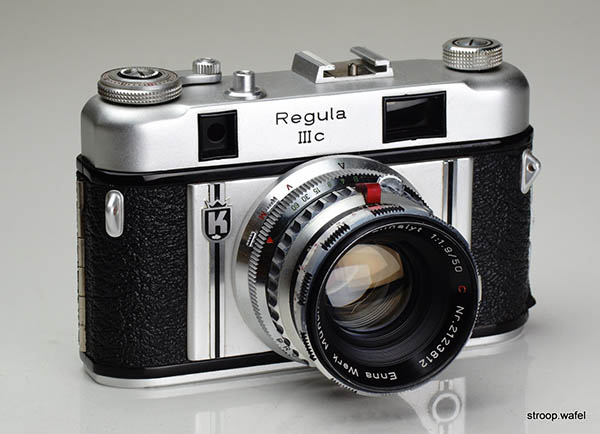
A King Regula IIIc with Enna Werk M�nchen Regula-Ennalyt C 50mm f/1.9 lens. Three fast standard lenses were available for the Regula range, the Ennalyt shown here, the Isco Westagon and the Steinheil Quinon, although the latter wasn't introduced until the King Regula Super. The Ennalyt appears to be the rarest of the lot.
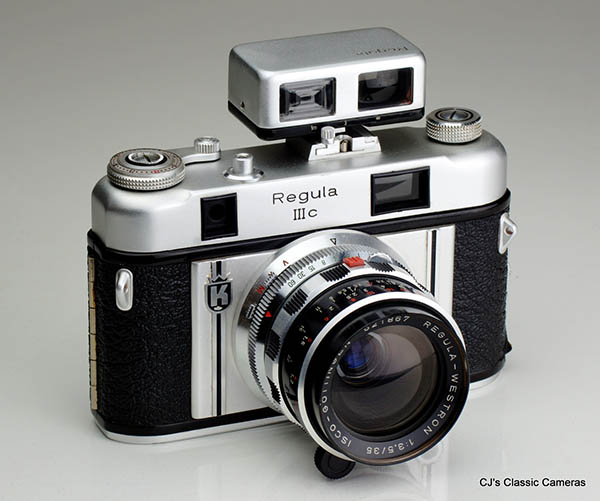
The King Regula IIIc (or the IIId below for that matter) lacked viewfinder frames for lenses other than the standard lens. Therefore, a separate viewfinder with 90mm and 135 frame lines was available (in addition to the standard 50mm one), with the full view covering the 35 mm focal length, to be uesed with wide angle and telelenses like the Isco Westron 35mm f3/.5 lens shown on the camera.
King Regula RM
The King Regula RM, like the IIId, came in two versions. The first was virtually identical to the Cita III, featuring a coupled rangefinder, exposure meter and helical focussing. The second version received the same cosmetic changes as the second version of the IIId: a larger viewfinder window, a larger light meter cell without flap and a dial on top of the camera.
This camera came commonly with a Carl Zeiss Tessar or Steinheil Cassar lens, however, the prize model was the one with the 45mm f/1.9 Ennalyt by Enna Werk M�nchen, one of the fastest fixed lenses of that era. They are rather rare but can in fact be found on both Regula RM variants, so having one of each really gives you bragging rights! I'm not quite there yet. At least around 750 of these were produced, based on the lens serial# I have seen. A King Regula R without lightmeter was also produced (see below).

First version of the King Regula RM with very fast 45mm f/1.9 Ennalyt lens. Apart from the strap lugs, this RM version was identical to the Cita III.
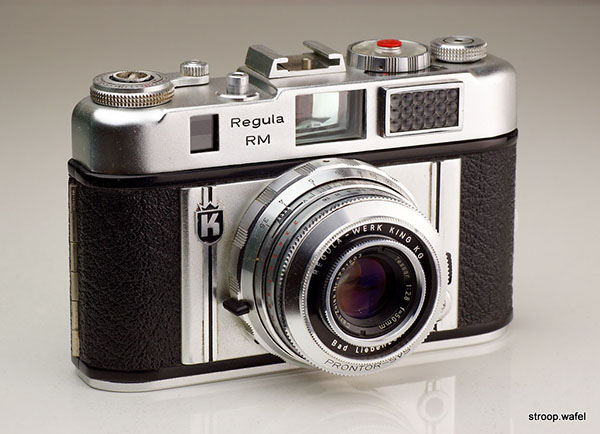
Second version of the King Regula RM with a Carl Zeiss Tessar 50mm f/2.8 lens.
King Regula R
The King Regula R was similar to the first version of the Regula RM, the main difference being the lack of a lightmeter. It did, however, have a wider rangefinder base which should in principle result in more accurate focussing. It was also very similar to the King Regula IIIc (which had a similarly wide rangefinder base) but with a fixed lens instead of an interchangeable one.
This appears to be the rarest Regula III series model, as I have only seen very few, and it looks like it was never updated to a secon version like the Regula RM was. I think it was only available with a Steinheil Cassar f/2.8 lens, although a 1957 'Popular Photography' review of the King Regula range does mention the f/1.9 Ennalyt being an option. If these indeed exist these surely must be the rarest Regulas.
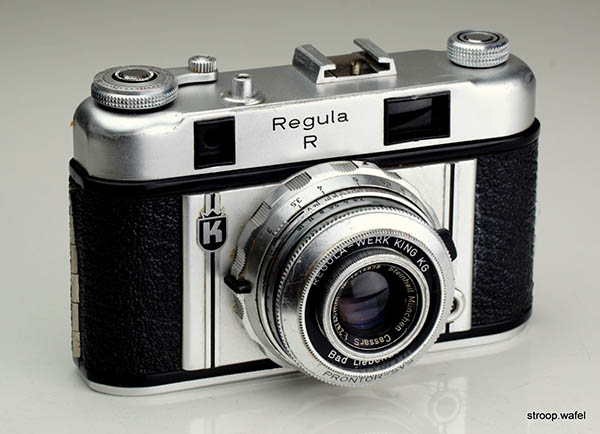
King Regula R with Steinheil Cassar 45mm f/2.8 lens in Prontor-SVS lens.
King Regula IIIbk
The King Regula IIIbk featured quite a few changes compared to the Regula IIIb. First of all the light meter moved to the right of the camera and the viewfinder to the left. The viewfinder was still the smaller, framed style as found on the early versions of the series III models. The light meter display was in the middle of the top housing and was coupled to the exposure setting on the shutter. While adjusting the exposure a marker would move, if it aligned with the light meter needle the exposure was correct. To my knowledge this was one of the first cameras to have this feature.
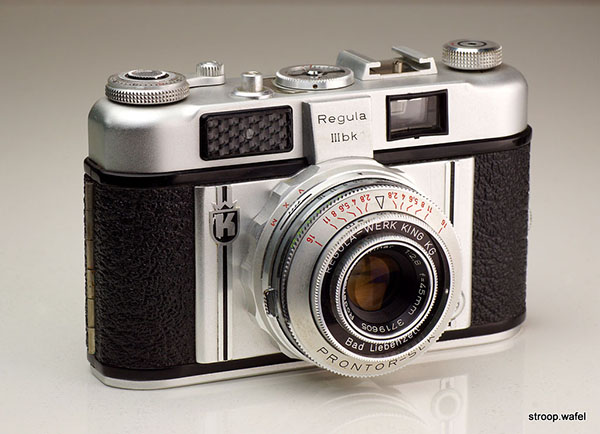
King Regula IIIbk, one of the first cameras with a coupled light meter.
King Regula IIId automatic
The King Regula IIId automatic was similar to the second version of the Regula IIId but had a coupled light meter, like the Regula IIIbk. The bright-frame viewfinder had no less than 4 frames, for 35mm, 50mm, 90m and 135mm lenses. Including the rangefinder patch this made for busy viewing!
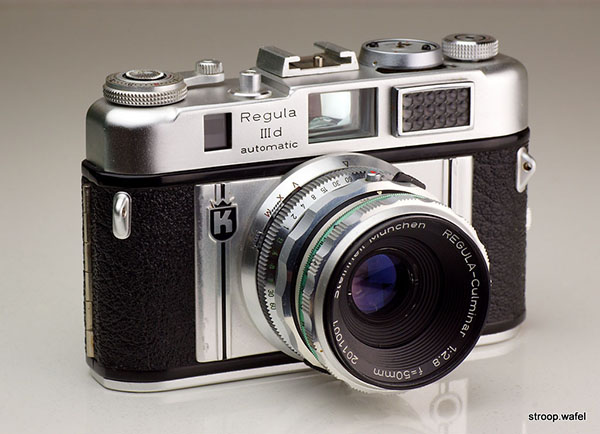
King Regula IIId Automatic with Steinheil Culminar f/2.8 lens
King Regula IIIbk automatic
The King Regula IIIbk automatic appears to be absolutely identical to the IIIbk, including the viewfinder, which on other models had been updated to a larger, brighter version. I suspect the 'automatic' part was simply added to make it more obvious to potential buyers that this model had a coupled light meter, just like on the IIId automatic.
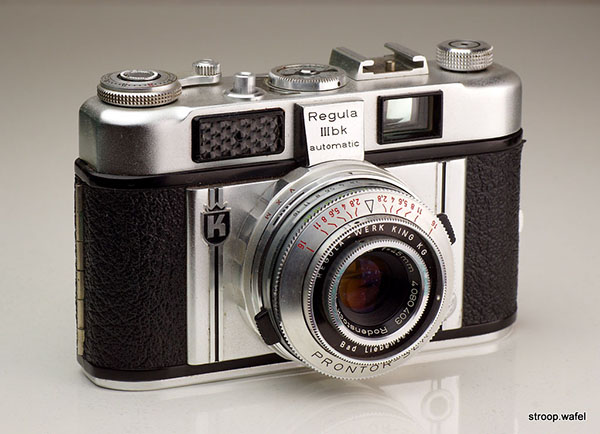
King Regula IIIbk automatic, seemingly identical to the IIIbk apart from the label 'automatic' on the front.
King Regula Super
The 1959 King Regula Super and Super Automatic had very different bodies compared to the III series and should perhaps not be listed here. However, they were the last of a kind: like so many other German camera manufacturers, the Regula-Werk King company had started making cheap plastic cameras like the Sprint and Sprinty. The King Regula Super was a welcome exception. It had an interchangeable lens mount and featured a switch that projected a different frame in the viewfinder for lenses of different focal length. Thus, the viewfinder image was not as busy as on the IIId Automatic. It also had parallax correction, helping in composing shots at close distance. It featured an uncoupled light meter that provided an LV value, to be used to set the exposure settings on the shutter. Like so many cameras from that time, the shutter release moved to the front of the body. Available lenses included a Steinheil Culminar 50mm f/2.8 and Isco Color-Westanar 50mm f/2.8.

King Regula Super with Isco Color-Westanar 50mm f.2.8 lens.

Top view of King Regula Super showing the switch for different viewfinder frames. A previous owner must have grown so tired of the small rewind knob on this camera that he/she decided to butcher it.
King Regula Super Automatic
The King Regula Super Automatic was identical to the Regula Super, other than that it had a coupled light meter like the Regula IIId Automatic. This camera was available with a fast Steinheil Quinon 50mm f/1.9 lens, which have achieved astronomical prices on eBay lately. An equally fast ISCO Westagon lens was also available.
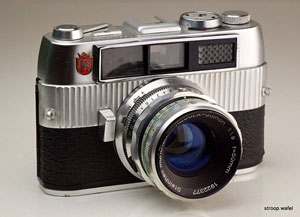
King Regula Super Automatic with Steinheil Quinon f/1.9 lens.
Later models
As a 'bonus', some of the later cameras made by Regula-Werk King, a Regula Regulette and a Picca-Mat. Mainly made of plastic and with no distinguishing features, these were aimed at the cheaper segment of the market. A good deal of different models like these existed, so it appears they were reasonably popular, also indicated by the company still being afloat until the mid-80s.
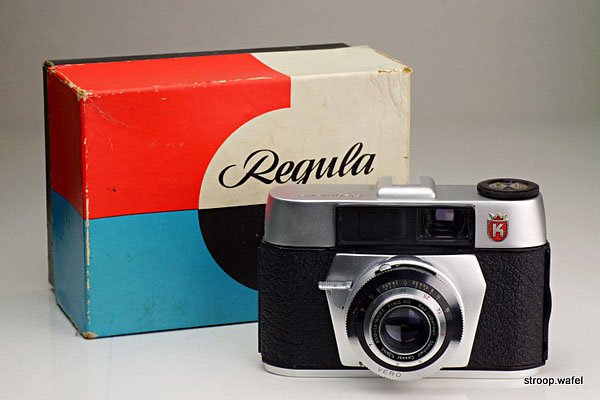
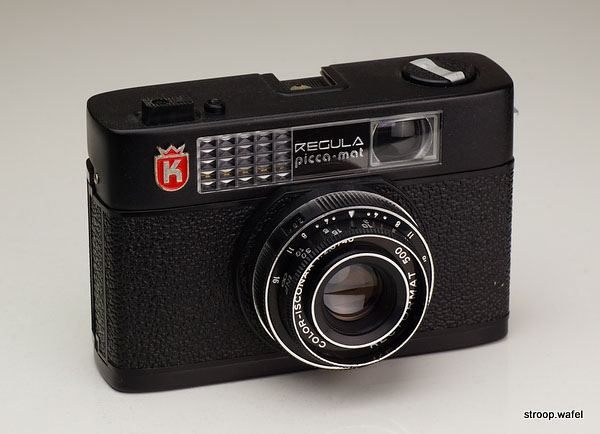 OGA (King Regula LKB)
OGA (King Regula LKB)
This is a rebranded King Regula LKB sold under the name OGA. See the Cita III further up the page for another OGA branded model and for some more details on OGA itself. The Regula LKB itself also exists in several variants, this appears to be a later version. It was equipped with coupled lightmeter as well as brightline viewfinder. It was also sold as Porst KB500. Porst was a large mailorder company that sold many cameras under the name Hapo and later Porst. The round plastic part on top of the camera was a plastic window that allowed for the lightmeter needle to be viewed in the viewfinder window.
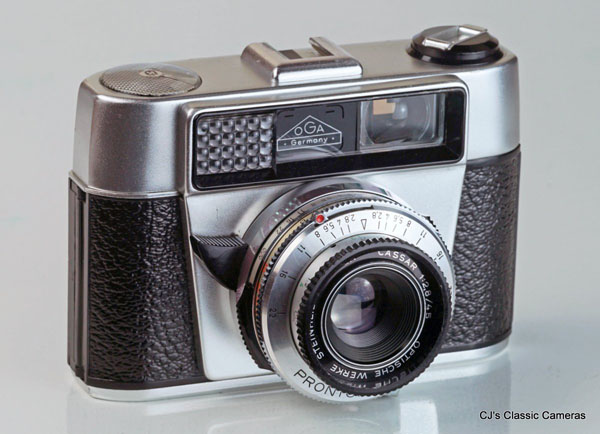
King Regula LKB with Steinheil Cassar lens in Prontor 500 LK shutter.
A 1960 King Regula Regulette and an early 70s black Picca-mat.
The King Regula Miniking-LK was a 110 film compact camera with coupled lightmeter introduced in 1975. King produced several fairly middle-of-the-road 110 cameras that are quite hard to find nowadays, so they were either not very popular, or ended up in bins or closets. The camera had a coupled lightmeter with an exposure range from 1/30 at f/4.5 to 1/500 at f/11. There was no means of focussing the lens, but considering the small frame size and small largest aperture depth-of-field was large enough not to have to worry about focussing. The camera also featured a socket for flash cubes. The Miniking-LK took 110 cassettes like the ones introduced by Kodak.

A King Regula Miniking-LK with Regulon 25mm f/4.5 lens. The camera appears to have a CdS lightmeter cell but no battery compartment, so presumably it had a built-in battery (see below). This might explain why the lightmeter no longer works on this example, the battery is unlikely to still work.
(left) Miniking-LK with top removed, it looks like the built-in battery may be located beneath the exposure dial; (right) viewfinder image of the Miniking-LK, showing exposure setting at the top and coupled lightmeter needle at the left
Finally, a King Regula Olympia Auto-Set III rebranded as Reporter and as such sold by Kaufhaus, a German chain of department stores. This camera was quite similar visually and functionally to the Braun Paxette Electromatic range, an example of which can be found elsewhere on this site. The camera would select a shutter speed based on the selected ISO setting and an aperture based on the available light as measured by the large selenium cell. A little tab in the viewfinder would indicate that aperture value or a red light if if light was insufficient. The great benefit of this model was that it had a fully manual mode, in contrast to the Auto-Set I and II models. All in all not a bad camera but no match for King's earlier Regulas.
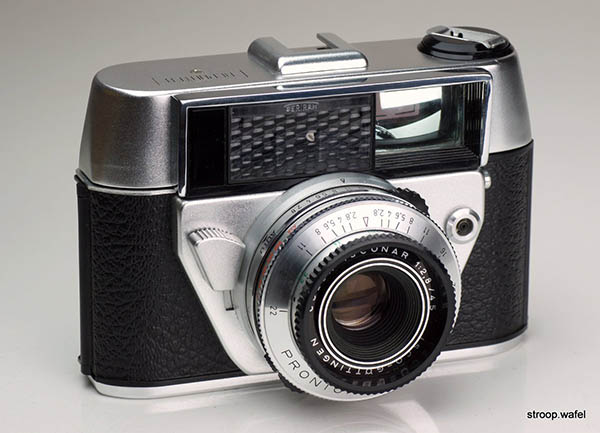
A King Regula Olympia Auto-Set III rebranded as Reporter with Isconar 45mm f/2.8 lens in Prontor-Matic 500 shutter.
| 
